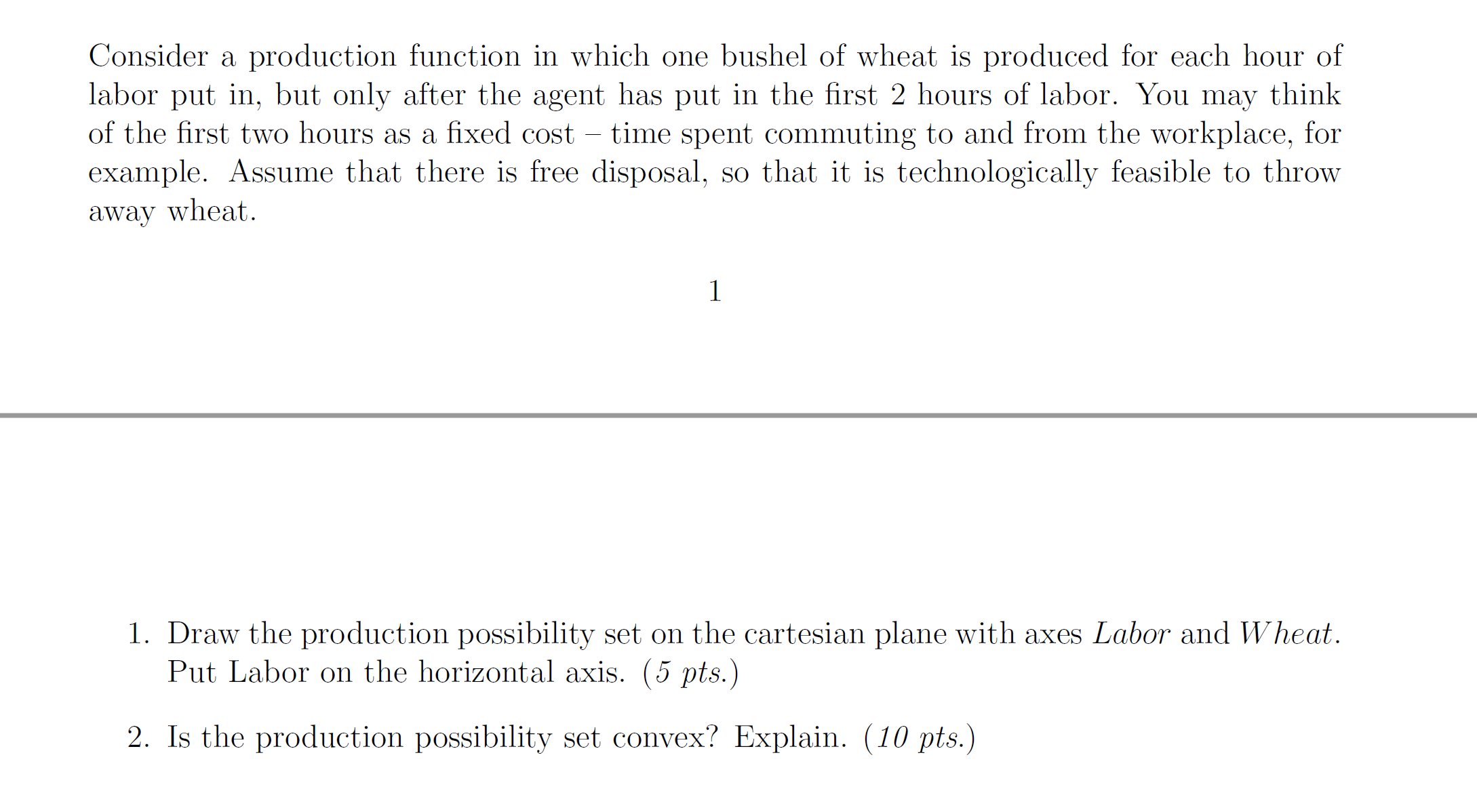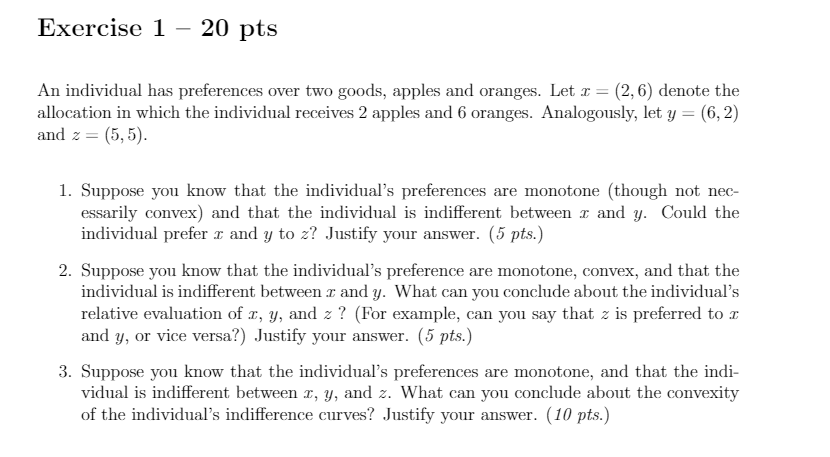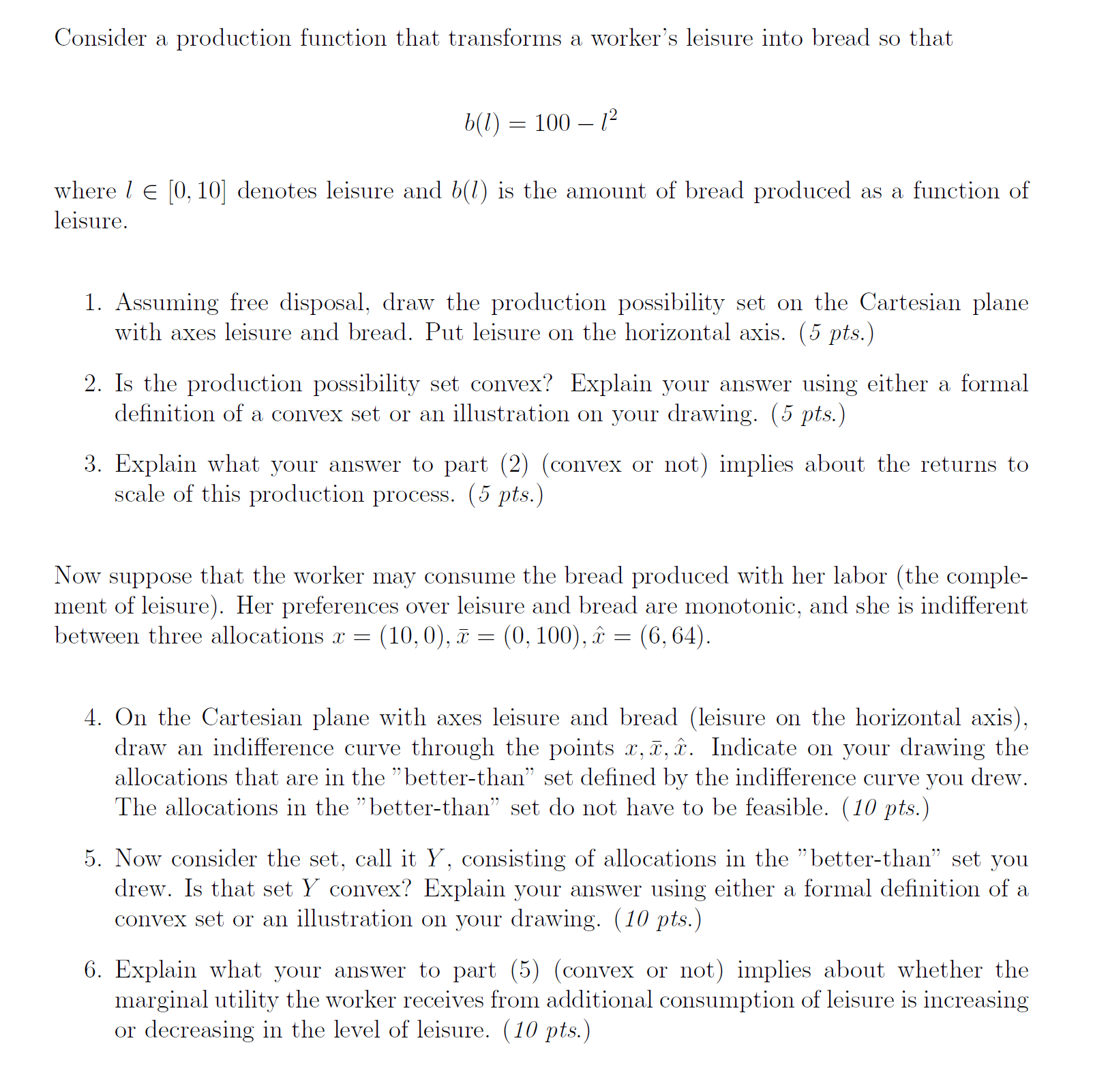



I would like all these questions answered, I submitted them individually and have not got a response.
Consider a production function in which one bushel of wheat is produced for each hour of labor put in, but only after the agent has put in the first 2 hours of labor. You may think of the first two hours as a fixed cost - time spent commuting to and from the workplace, for example. Assume that there is free disposal, so that it is technologically feasible to throw away wheat. 1. Draw the production possibility set on the cartesian plane with axes Labor and Wheat. Put Labor on the horizontal axis. (5 pts. ) 2. Is the production possibility set convex? Explain. (10 pts.)Exercise 1 20 pts An individual has preferences over two goods, apples and oranges. Let a: : [2, 6) denote the allocation in which the individual receives 2 apples and 6 oranges. Analogously, let '3; z [6, 2) and z = [5, 5}. 1. Suppose you know that the individuals preferences are monotone [though not nec- essarily convex) and that the individual is indifferent between a: and 3;. Could the individual prefer :1; and y to z? Justify your answer. [5 pta} 2. Suppose you know that the individual's preference are monotone, convex, and that the individual is indiEerent between a: and 3;. What can you conclude about the individual's relative evaluation of :5, y, and z ? [For example, can you say that z is preferred to a: and y, or vice versa?) Justify your answer. [5 pta} 3. Suppose you know that the individual's preferences are monotone, and that the indi- vidual is indiiferent between 3:, y, and z. 1What can you conclude about the convexity of the individual's indifference curves? Justify your answer. [10 pta.) Consider a production function that transforms a workerjs leisure into bread so that 5(5) 2 100 52 where l E [0, 10] denotes leisure and 5(5) is the amount of bread produced as a function of leisure. 1. Assuming free disposal, draw the production possibility set on the Cartesian plane with axes leisure and bread. Put leisure on the horizontal axis. (5 pts.) 2. Is the production possibility set convex? Explain your answer using either a formal denition of a convex set or an illustration on your drawing. (5 pts.) 3. Explain what your answer to part (2) (convex or not) implies about the returns to scale of this production process. (5 pts.) Now suppose that the worker may consume the bread produced with her labor (the comple ment of leisure). Her preferences over leisure and bread are monotonic, and she is indifferent between three allocations CU : (10,0), E : (0, 100), i : (6, 64). 4. On the Cartesian plane with axes leisure and bread (leisure on the horizontal axis), draw an indifference curve through the points 33, :E, 1%. Indicate on your drawing the allocations that are in the \"betterthan\" set dened by the indifference curve you drew. The allocations in the \"betterthan\" set do not have to be feasible. (10 pts.) 5. Now consider the set, call it Y, consisting of allocations in the \"betterthan\" set you drew. Is that set Y convex? Explain your answer using either a formal denition of a convex set or an illustration on your drawing. (10 pts.) 6. Explain what your answer to part (5) (convex or not) implies about whether the marginal utility the worker receives from additional consumption of leisure is increasing or decreasing in the level of leisure. (10 pts.) Jane has a utility of $5 for being on the swing. Dick has a utility of $3 for being on the swing. First, let us consider the set of allocations where the swing goes to one of the two kids. The swing is the only good in this economy. 1. Does the allocation where Jane gets the swing Paretodominate the allocation where Dick gets the swing? (5 pts.) 2. What is the set of Pareto optimal allocations? (5 pts.) Now, assume that each kid has $10 in his pocket. In this economy there are two goods, swing and money. Thus, an allocation prescribes who gets the swing as well as a division of the total amount of money in society ($20). Let us consider the set of allocations of swing and money. Show that the allocation where Dick gets the swing and each kid keeps $10 is Paretodominated. (10 pts.)














